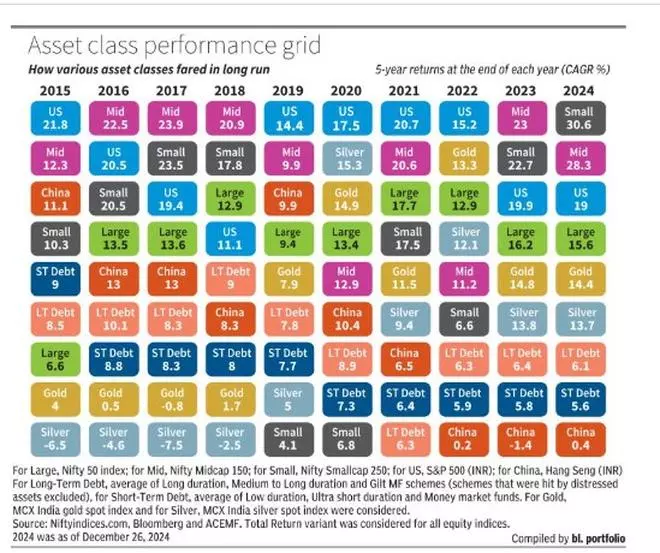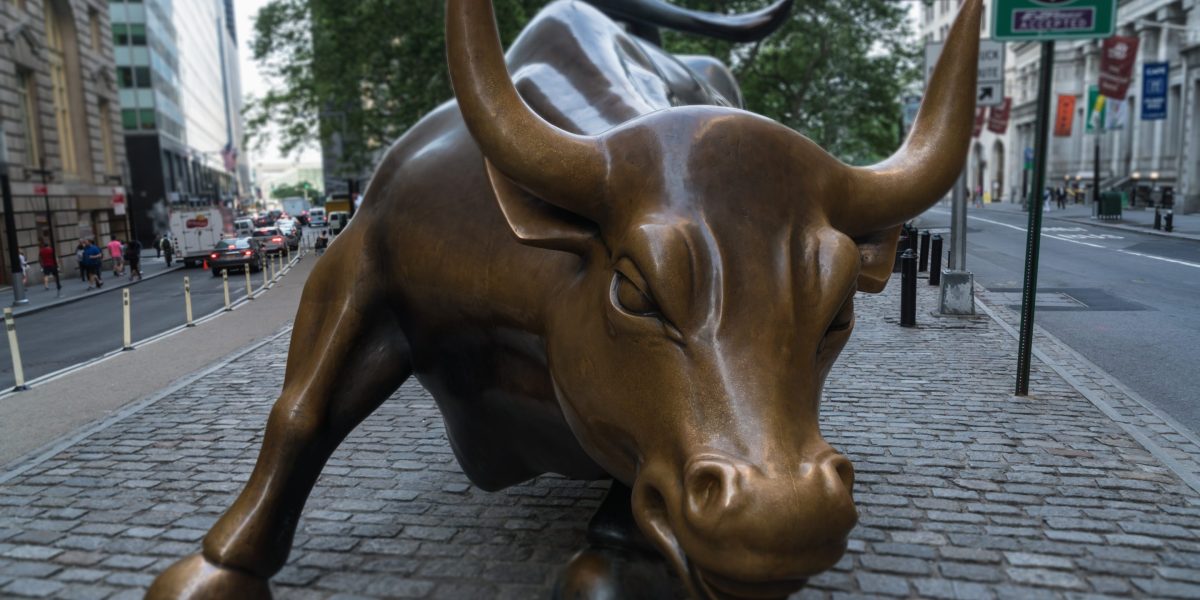Today, Indian investors have many financial investment asset classes – domestic and foreign, to bet on. In CY24, they have not been let down by any of them. All delivered positive returns in the calendar year, with equities topping the list.
As far as the long-term performance is concerned, small- and mid-cap stocks top the chart in 2024 and outperformed the other asset classes.
The accompanying chart exhibits the relative long-term performance of the most liquid financial asset classes accessible to Indian investors. We considered large-cap, mid-cap, small-cap, gold, silver, US equities, Chinese equities, long-term debt and short-term debt and, computed the five-year returns at the end of each year for the last ten years. The assets were picked based on invisibility option for Indian investors via direct investing or mutual funds/ETFs.
- Read: Mid-cap, small-cap mutual funds attract ₹30,350 crore in H1 FY25
Mid-caps on top
Overall, when looking at long-term performance, mid-caps outperformed large-caps and small-caps in terms of consistency and relatively better returns.
In the last five-year timeframe ended 2024, the Nifty Smallcap 250 Total Return Index (TRI), which represents small-cap stocks, produced a compound annualised return of 30.6 per cent, while the mid-caps as represented by Nifty Midcap 150 TRI, delivered a return of 28.3 per cent.
The domestic equities market demonstrated stellar show after the pandemic, despite short-term turbulences.
Trivesh D, COO Tradejini says, “However, this stellar performance may not carry forward into 2025. Market dynamics indicate that growth across segments is likely to moderate, with mid-single-digit returns being a realistic projection. Large caps may continue to provide stability but face valuation pressures, while mid and small caps could witness uneven performance due to slower earnings growth and heightened regulatory scrutiny”.
- Read more: Active investing fares well in small-cap space
Over the last 15 years, mid-caps have consistently outperformed large-caps and small-caps in the majority of timeframes, as the table illustrates.
US and China
Over the last two years, US equities delivered better returns compared to the large-cap stocks in the domestic market. This growth has been largely driven by the ‘Magnificent 7 ’ — Apple, Amazon, Alphabet, Meta, Microsoft, Nvidia and Tesla — backed by strong earnings and major investments in artificial intelligence (AI).

Further rupee depreciation has boosted 5 year returns for an Indian investor. For example, while the last 5-year CAGR of S&P 500 total returns (including dividends) is 15 per cent in USD terms, it increases to 19 per cent in INR terms.
“In 2024, the US market has become much more balanced,” said Pratik Oswal, head of passive funds at Motilal Oswal AMC. The 450-490 companies that had not performed well last year have also recovered in 2024 and demonstrated better returns, he added.
Macroeconomic factors such as the US Federal Reserve’s policy rate cut rate and the likelihood of more in the offing, and the easing of the rate of inflation have been favourable factors, leading to a resurgence in US stocks, Oswal said.
After three years of underperformance, Chinese stocks came into the limelight thanks to the stimulus measures announced by the Chinese government in October 2024. The policy measure announced were aimed at supporting a weak property sector, increase retail consumption and boost capital markets. A China-focussed ETF trading in India returned 29 per cent this year, although 5-year CAGR was flat.
- Also read:Investors flock to sectoral mid-, small-caps, despite choppy market
Debt – a balancing act
The years 2018–2022 were not so good for the domestic fixed income markets, due to multiple headwinds. However, things changed over the last 18-20 months due to few factors including significant FII (foreign institutional investors) inflows into Indian government bonds and expectations of a rate cut cycle.
Devang Shah, Head Fixed Income, Axis Mutual Fund, said, “For 2025, we believe the RBI will cut rates, driving performance of bond markets. We expect a 50-basis points rate cut in the next six months. The reasons for this would be slower GDP growth, as seen in the lower Q2 GDP, with Q3 and Q4 also expected to be lower. This would prompt the RBI to change its course and start cutting rates”.
Your asset allocation plan should include debt funds since they may act as a buffer when other asset classes decline.
Both gold and silver glitter
Gold, as an asset class, is used as a store of value and a hedge against stock market volatility amid economic uncertainties. Despite short-term blips, gold prices have been on the rise since October 2022. The yellow metal has delivered a solid CAGR of 14.4 per cent over the last five years in rupee terms. Expected rate cuts by major economies and persisting geopolitical tensions led to a significant surge in gold price.
Chirag Mehta, CIO, Quantum AMC said, “The surge in gold prices is anticipated to persist into 2025, with the trajectory expected to be influenced significantly by the return of President Donald Trump to office, which could herald a series of policy changes and strategic decisions.” Expected rate cuts by major economies and persisting geopolitical tensions could also lead to a significant surge in gold price he added.
While the gold has been the mainstay of investors’ portfolio for years for diversification into commodities, the silver has also gained traction among investors.
Silver is a key component in solar panels and other renewable energy technologies. The increasing demand for these technologies has driven up the demand for silver.
Manish Banthia, CIO Fixed Income, ICICI Prudential AMC said, “The outlook for silver in 2025 is shaped by two key factors: its relationship with gold as a proxy in the precious metals space and its industrial demand dynamics”.
The year 2025 presents a challenging macroeconomic environment in the United States, characterized by elevated debt levels and a substantial fiscal deficit. Gold, traditionally seen as a hedge against risk, is likely to benefit from these uncertainties, and this positive sentiment could extend to silver, given its dual role as a precious and industrial metal Banthia added.
Secondly, the ongoing surge in power sector investments and electric vehicles (EVs) investments continues because of new age applications demand for silver may remain robust. Should these trends persist, silver’s industrial value will likely remain strong Banthia explained.
Silver, in rupee term, delivered a CAGR return of 13.7 per cent in the last five years. However, gold outperformed silver over long run in most time frames, as the table illustrates.








Leave a Comment